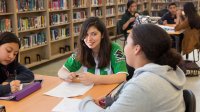Teaching Students How—and When—to Change Their Minds
Learning involves accepting uncertainty and evolving your thinking. Here’s how teachers can help students cultivate those skills.
Your content has been saved!
Go to My Saved Content.The process of learning often requires a willingness to consider new and sometimes conflicting information—and then use that information to update an opinion or form a new one. In the classroom, that’s a skill educators can model, and provide students with opportunities to practice, writes Katherine Burd for Education Week.
“The skill of changing one’s mind … benefit[s] learners, workplaces, and society as a whole,” writes Burd, who teaches English at The Chapin School, an independent K-12 school in New York City. “Developing and articulating an informed opinion, then considering new information seriously enough to change that opinion can stimulate new creativity in adult workplaces. This same process is also vital to democracy, where we must always be ready to change the way that we view issues as we learn more about them,” she concludes, touching upon a quality that’s been in short supply recently.
For students to learn these increasingly important (and rare) skills, schools must communicate the idea that they value students’ ability to practice flexible thinking and to accommodate uncertainty—but that mindset can be difficult to track through traditional assessment practices. “Though the process of learning requires a student to change her mind, our classrooms still mostly assess a student based on her ability to demonstrate a single concrete view,” writes Burd. While there are clearly facts that are beyond dispute and are unchangeable, when schools “mostly value student work that demonstrates certainty alone, then we reinforce the dangerous, unproductive idea that certainty is what matters.”
There are ways that educators can incorporate practices that nudge students toward developing and changing their opinions, Burd says. We took a few ideas from her original article and a few from our Edutopia archives; practices designed to cultivate in students the ability to stretch their thinking and incorporate new perspectives and knowledge.
Change classroom discussions: When educators set up “well-structured classroom discussions which teach and assess students’ ability to consider one another’s perspectives,” it can help shift the focus from “argumentation to idea evolution,” writes Burd.
At Highlander Charter School, classroom discussions about controversial topics form a regular part of the curriculum and students are expected to research, consider, and discuss issues from different perspectives. “Our students come with these very firm ideas and beliefs about certain topics, because it’s the only perspective they’ve known. So I really like to push the envelope with them,” says Soljane Martinez, a civics and social justice teacher at Highlander. “It’s a really important skill for you to have, looking at things from the point of view of someone who has a different opinion. It’s not a wrong versus right. It’s a ‘well, you know what? Let me take a step over to your side’.”
In Martinez’s 12th grade civics class, students gather in small groups, read through online resources on a topic such as LGBTQ rights, or who is to blame for poverty, then get into discussions during which they take opposing views and practice discussing sensitive topics respectfully and listening to opposing viewpoints with an open mind.
Highlight evolving thinking: Tasks that help students reflect on and describe their thinking process can help them build the skills to develop—and adjust—their viewpoint. “Templates for thinking about one’s own thinking already exist: structured process-writing assignments, problem sets and lab reports that ask students to submit, alongside final drafts, logic maps and thinking narratives that flag moments of idea development,” writes Burd.
She also recommends remediation projects, “which ask students to translate core understandings of course material to new media forms,” and encourage students to consider concepts from new perspectives.
Model hidden thinking and self-talk: When educator Stephanie Toro models how to solve a problem for students in her STEM classes, “I talk about every aspect of what I am doing out loud. In fact, I over-talk, providing reasoning for every step,” writes Toro, who is an assistant professor at the Universidad de los Andes in Bogotá, Colombia. “I will even include moments of vulnerability and model the fact that I don’t always know what to do, but I will discuss my options and my decision process.”
As her students observe Toro work through a problem, she likes to intentionally make mistakes and then demonstrate how to check her work to correct errors. That modeling helps students understand that thinking can evolve, that even adults need to work through ideas, perhaps absorb new information, rethink their steps, to arrive at new solutions. “It’s essential that we explicitly show students this internal dialogue to model problem-solving,” Toro writes.
Abandon your own certainty: For kids to learn the value of keeping a flexible mindset, adults in all spheres of students’ lives need to model it themselves. “We—not just educators, but also school leaders, politicians, parents, and citizens—need to abandon our own desires to present certainty in our opinions and start revealing just how often we, too, change,” Burd writes. “Many students believe that their teachers should show absolute mastery of and certainty about material. When a teacher admits to a deficit in knowledge or understanding, though, she opens up space for students to explore and understand on their own.”
